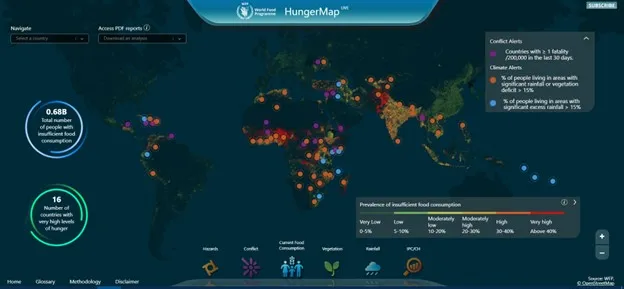“Nutrition needs a data revolution” – Global Nutrition Report, 2014
Is Artificial Intelligence (AI) the long-awaited answer to the call for a nutrition data revolution? AI is transforming the ways we can collect, collate, analyze, translate and use data. However, there are limitations to how we should leverage AI if our goal is to build strong and impactful nutrition data value chains.
AI is a general term for computer systems ability to perform tasks normally requiring human intelligence, such as visual perception, speech recognition, decision making, and language. Machine learning is a subtype of AI in which a computer reviews large volumes of data to discover trends and patterns that it uses to develop and improve predictive models. Examples of more specific machine learning techniques relevant to nutrition data include computer vision for image data and natural language processing focused for text and speech data.

A few recent examples of AI methods being used to collect, analyze, and translate nutrition data to decision makers include:
- Food Recognition Assistance and Nudging Insights (FRANI) is a smart phone application that analyzes dietary intake from photos captured by school-age children. It has been validated against weighted records and 24-hour-recalls in Ghana and Viet Nam.
- Child Growth Monitor is a mobile app that uses machine learning to take anthropometric measurements of children. It is currently used for clinical applications but holds potential for population-based data collection.
- World Food Program (WFP) has multiple AI initiatives including Hunger Map which combines publicly available data on food security, weather, conflict, and nutrition to track and predict food security in near real time and Modelling and Mapping Inadequate Micronutrient Intake (MIMI) project uses machine learning to fill gaps in data on risk of inadequate micronutrient intakes.

“By far, the greatest danger of Artificial Intelligence is that people conclude too early that they understand it.”
—Eliezer Yudkowsky
Alongside AI advances, there are calls for restraint and responsible use of new technologies. Critics cite issues with data privacy, bias, discrimination, inequity, security, and validity among others.
DataDENT aims to embrace AI’s potential while continuing to invest in foundational elements of the nutrition data value chain. We are particularly concerned about the misconception that AI can substitute for primary nutrition data collection.
Many countries lack essential data to inform micronutrient supplementation, large-scale food fortification, non-communicable disease prevention, and other nutrition policies and programs. Taking the example of micronutrient status data, 77 LMICs (56%) had population-based data for vitamin A status of preschool age children between 1998-2018 while only 53 (38%) had estimates of iron status and 21 (15%) of zinc in preschoolers. Data for other populations including school-age children, adolescents, adult men, and the elderly are even more scarce.
Collection of primary micronutrient status data is costly in terms of money, time, and technical capacity. Donors are funding multiple micronutrient data modeling initiatives that leverage AI to fill data gaps. These initiatives are important, but the need for continued investment in primary data collection cannot be understated. Models are only as good as the data used to train them. If the input data being used as model inputs are sparse or non-representative, the modeled results may be biased or inaccurate.
Investments in primary data collection and modeling methods should be seen as complementary. For example, models can complement primary data collection by providing more granular subnational or sub-group estimates. AI can also make primary data collection more accurate and less costly – as in the FRANI and Child Growth Monitor examples.
DataDENT’s complementary strategy to fill gaps in nutrition intervention coverage data includes improving primary data collection methods and developing analytical methods that leverage AI.
Our ongoing formative research will improve the validity of household survey questions about micronutrient supplements during pregnancy, maternal, infant, and young child nutrition counseling, nutrition sensitive social protection, and large-scale food fortification. On the analysis side, DataDENT machine learning algorithms will estimate the combined coverage of multiple nutrition interventions within specific sub-populations and potentially fill in missing data for key interventions. Our model building process includes assessing completeness and representativeness of data prior to including in analyses, properly vetting data quality and ensuring transparency in model building.
Furthermore, DataDENT is supporting government and development partners in Nigeria and Ethiopia to develop multi-sector nutrition data strategies that recommend filing data gaps using a combination of primary data collection and modeled estimates. These costed plans will help nutrition stakeholders advocate for nutrition information system funding. Finally, DataDENT is continuing to work in partnership with others to identify essential elements of nutrition data literacy and effective capacity strengthening approaches. Responsible use of AI requires data literate people who can ask the right questions of models, verify the outputs, and appropriately use the findings.
AI is a powerful tool with potential to strengthen nutrition data value chains. DataDENT is building the foundation of primary data collection, strategic planning and nutrition data literacy which will allow countries to leverage AI for good rather than to create new data problems.
